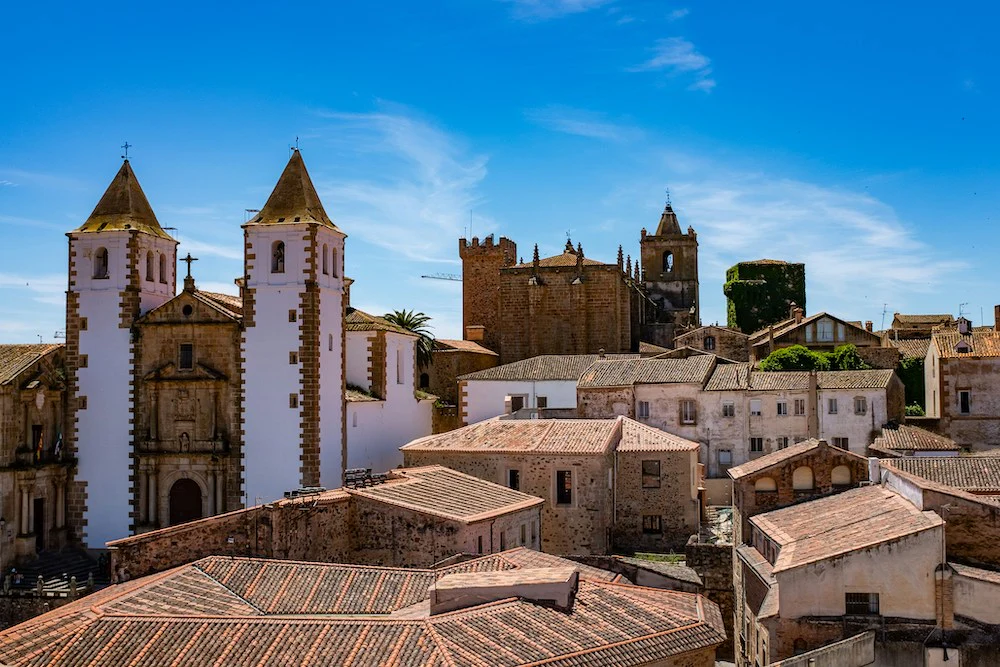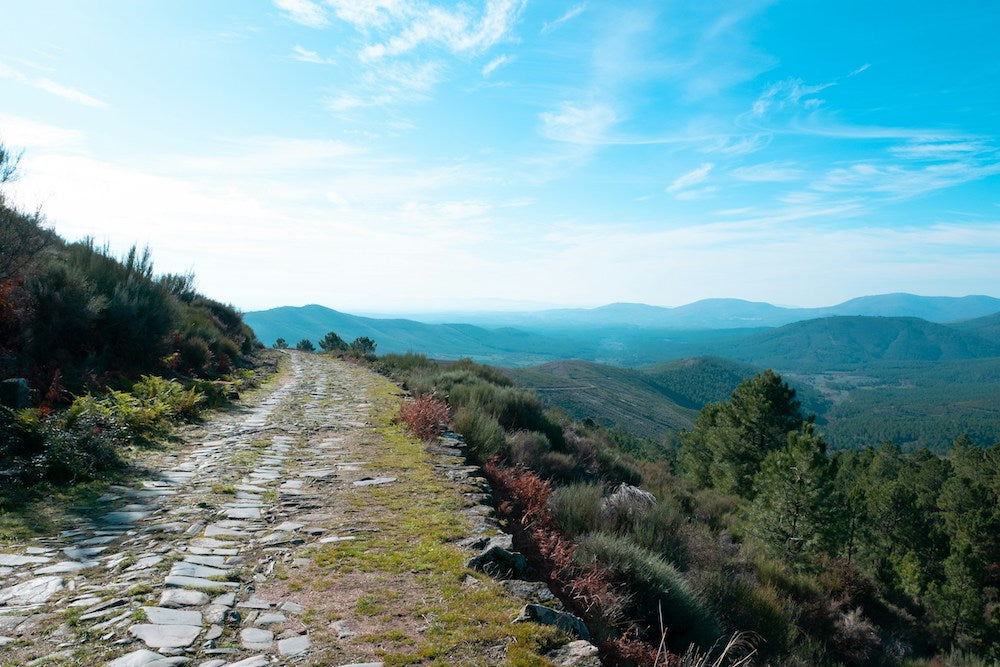
Discover Cáceres in spring: an unknown gem in Spain
In the vast mosaic of tourist destinations that Spain offers, Cáceres stands as a hidden gem, waiting to be discovered by travelers eager for authentic experiences and breathtaking landscapes. Although it may not be as famous as other Spanish cities, such as Barcelona, Madrid or any city in the south of Spain, Cáceres offers a unique charm that captivates those lucky enough to explore it, especially during the spring season, when the city and its surroundings are dressed in the vibrant colors of the season.
History and heritage of Cáceres
The history of Cáceres is as ancient as it is fascinating, with evidence of human settlements dating back to prehistoric times. Located in the Extremadura region in southwestern Spain, its strategic position between the Meseta Central and the Guadiana plain made it an important enclave over the centuries.
During Roman times, Cáceres, then known as "Castra Caecilia", was a military settlement that served as a checkpoint on the Vía de la Plata, an important trade route connecting Mérida with Astorga. The Romans left their mark on the city in the form of monuments, such as the Arch of Trajan, which is still preserved in the old town.
With the fall of the Roman Empire, Cáceres went through various periods of Visigoth and Muslim domination, during which its strategic importance was maintained. It was during the Muslim occupation that the city acquired the name "Qazris" and the walls surrounding the old town were built, some of which are still preserved today.
The Christian reconquest of Cáceres took place in the 12th century, when Christian troops, led by Alfonso IX of León, took the city after a long siege. From then on, Cáceres experienced a period of growth and prosperity, with the construction of numerous palaces, churches and noble houses that still shape the charming old town today.
Over the following centuries, the city was the scene of conflicts and power struggles between the local noble families, which left their mark on the architecture and culture of Cáceres. In the 15th century, the city experienced a cultural and artistic renaissance, with the construction of numerous churches and convents in Gothic and Renaissance style.
In the 20th century, Cáceres suffered the ravages of the Spanish Civil War and the Franco dictatorship, but managed to recover and prosper in the following decades. In 1986, the city's old town was declared a World Heritage Site by UNESCO, in recognition of its rich history and impressive architecture.
Today, Cáceres is a modern and dynamic city that remains faithful to its historical roots. Its cobbled streets, charming squares and historic monuments bear witness to its glorious past, while its vibrant cultural life and exquisite gastronomy make it a unique tourist destination in Spain.
Nature and outdoor activities in Cáceres
Spring in Cáceres awakens a dreamlike landscape, where vibrant colours and lush nature come together to create an unforgettable experience. The fields and meadows surrounding the city are transformed into a tapestry of wild flowers, painting the land with a palette of tones that seem taken from an impressionist work of art.
For hiking enthusiasts, Cáceres offers a network of routes that wind through the nearby mountain ranges and valleys, offering stunning panoramic views and the opportunity to discover the region's rich flora and fauna.The Monfragüe National Park, just a few kilometres from the city, is a paradise for bird watchers, with a wide variety of species, including the majestic black vulture and the imperial eagle, which soar through the skies in a spectacle of natural beauty.

For those looking for a more relaxed experience, the area around Cáceres offers opportunities for activities such as mountain biking, exploring winding trails through lush forests and picturesque valleys. Stargazing is also a popular activity in the region, with clear, light-polluted skies offering a spectacular view of the heavens.
And for those who simply want to unwind and enjoy the tranquillity of nature, the surroundings of Cáceres are the perfect setting for a quiet picnic in the middle of the countryside. With crystal-clear streams and emerald green meadows as a backdrop, visitors can enjoy moments of peace and serenity in harmony with the natural surroundings.
Spring in Cáceres is much more than just a season of the year; it is a time to immerse yourself in the beauty and serenity of nature, exploring stunning landscapes and enjoying outdoor activities that feed the soul and renew the spirit.
Gastronomy and culture of Cáceres
The gastronomy of Cáceres is a feast for the senses, where each dish tells a story of tradition and flavour rooted in the Extremaduran land. Visitors can delight in a variety of delicacies that reflect the culinary richness of the region.
Tender and juicy, roast lamb is one of the star dishes of Cáceres cuisine. Skillfully prepared and seasoned with local aromatic herbs, this delicacy is a delight that will satisfy even the most demanding palates. Accompanied by roast potatoes or fresh vegetables, roast lamb is a true celebration of the flavours of Extremadura.
A unique take on the classic Spanish dish, Gazpacho Extremadura is another culinary treasure from Cáceres. Made with ripe tomatoes, peppers, cucumbers, garlic and olive oil, this refreshing and nutritious dish is perfect for hot spring days. Served cold and garnished with chunks of Iberian ham and hard-boiled egg, Gazpacho Extremadura is an explosion of flavours that will win over all diners.

And what can we say about Iberian ham, Spain's culinary treasure? Cáceres, with its rich tradition of breeding and producing this exquisite sausage, is the ideal place to sample this delicacy. With its soft texture and intense, aromatic flavour, Iberian ham from Cáceres is a true gift for the senses.
But the gastronomy of Cáceres is not limited to these traditional dishes. The city is also known for its exceptional wines, especially those from the Ribera del Guadiana Denomination of Origin. With a long history of winemaking and a climate favourable to the cultivation of vines, the region produces high-quality wines that perfectly complement any meal.
In addition to its exquisite food, Cáceres is a hive of cultural activity during the spring. The city comes alive with festivals and events celebrating local music, art and tradition. From open-air concerts in historic squares to folk dance performances in traditional theatres, there is something for all tastes and ages. Visitors can immerse themselves in the authenticity and welcoming spirit of the community, enjoying the vibrant cultural scene that makes Cáceres so popular. a unique destination in Spain.
The must-sees you can't miss in Cáceres
If you are planning to visit Cáceres, we bring you some places that are absolutely essential for you to include in your itinerary. These iconic sites capture the essence and history of the city, giving you an unforgettable experience:
- Monumental City: Begin your exploration in the historic heart of Cáceres, the Monumental City, declared a World Heritage Site by UNESCO in 1986. Let yourself get lost in its cobbled streets and cobblestone squares, marveling at the medieval and Renaissance architecture of its buildings.
- Co-Cathedral of Santa Maria: Visit this majestic Gothic church, whose imposing façade and elegant arches will transport you back to the Middle Ages. Explore its interior, adorned with religious works of art and impressive sculptures.
- Palace of the Weathervanes: Immerse yourself in the history of Cáceres at this Renaissance palace, which houses the Museo de Cáceres. Discover archaeological artefacts, paintings and exhibitions that illustrate the cultural evolution of the region over the centuries.
- Plaza Mayor: Stop by this charming square, the social heart of the city, where you can experience authentic Spanish life. Relax on a terrace with a glass of local wine and watch life go by while admiring the surrounding architecture.
- Monfragüe National Park: Escape the city and enter the unspoiled nature of Monfragüe National Park, a paradise for wildlife and outdoor adventure lovers. Hike along its trails, observe birds in their natural habitat and marvel at the stunning landscapes.
- Merida Gate: Don't miss this ancient entrance arch to the city, dating back to the 1st century AD. Admiring this Roman relic will transport you back in time and remind you of Cáceres' rich history as a crossroads of civilizations.
- Bujaco Tower: Climb this 12th-century Moorish defence tower to enjoy unparalleled panoramic views of the city and its surroundings. It is the perfect place to capture stunning photos and contemplate the beauty of Cáceres from above.
 Venture to discover this jewel in the Iberian Peninsula
Venture to discover this jewel in the Iberian Peninsula
Cáceres in spring is an experience that captivates the senses and the soul. With its impressive historical heritage, stunning natural landscapes, delicious cuisine and vibrant culture, this city offers travelers an unforgettable escape away from the crowds and well-trodden tourist destinations of Spain. Discovering Cáceres in spring is discovering an unknown gem that shines with its own light in the heart of Extremadura.
FAQ ABOUT CACERES
What is the best time to visit Cáceres?
Spring and autumn are the best times to visit Cáceres, as the weather is pleasant and the scenery is at its best. However, Cáceres has its charm all year round, with festivals and events taking place in all seasons.
What typical dishes can I try in Cáceres?
Typical dishes from Cáceres include roast lamb, gazpacho extremeño, Iberian ham and local cheeses. You can also enjoy a wide variety of wines from the region.
How to get to Cáceres from other cities in Spain?
Cáceres has good transport links, including trains and buses that connect it to other cities in Spain. You can also get there by car via the A-66 motorway.
What festivals and events are held in Cáceres?
Some of the most notable festivals and events in Cáceres include Holy Week, the WOMAD Festival, the Classical Theatre Festival and the San Fernando Fair.


